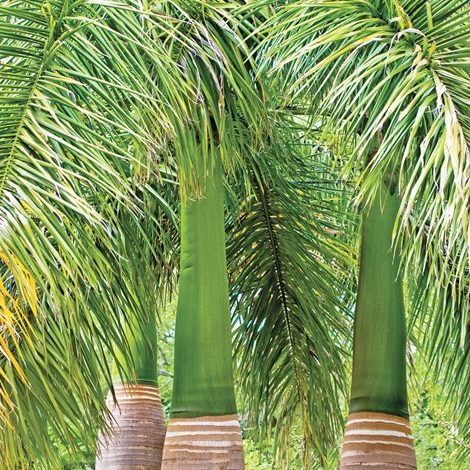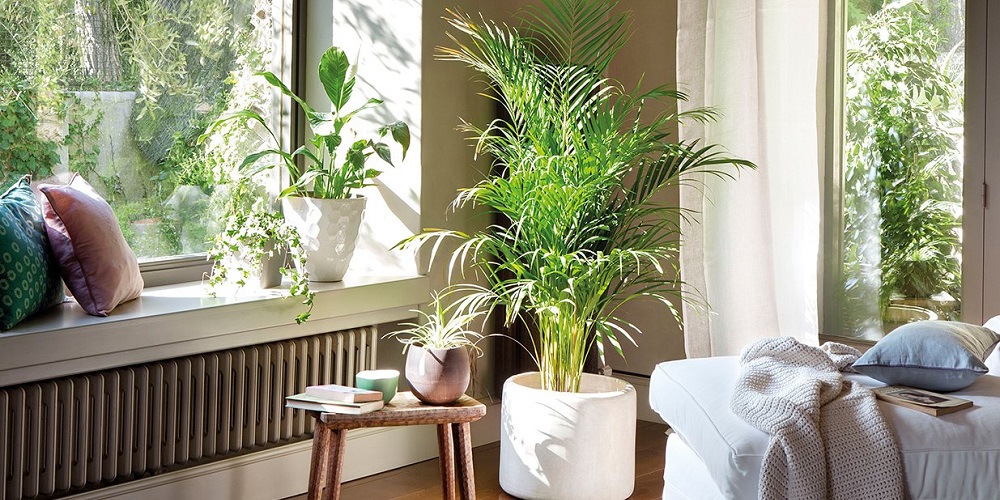What types of palm trees are used in gardening?

Having plants in the house or in the office is a way to improve a space, since visual aesthetics is something that cannot be neglected. In these cases, palm trees enjoy a special place and are one of the favorites when it comes to gardening or decoration.
Knowing the palm trees
Palm plants belong to the Arecaceae family and are classified into a wide variety of species, which can have aesthetic, medicinal, construction and more uses.
It is a fairly versatile plant and can even produce fruits and flowers, as well as being able to develop in environments with difficult conditions, mainly considering the composition of the types that have trunks, instead of stems.
They are usually leafy and have large green leaves, which, depending on their type, can produce considerable shade, which also makes it possible to take advantage of specimens that grow naturally.
In general, the types of dwarf palm trees are the preferred ones to have in the interiors of the houses, since they do not take up so much space, you do not need a large shovel to plant them and they can give a very colorful touch to any room.
If this is your case, we recommend paying more attention to the types of indoor palm trees that the market can offer you, considering that these usually have lower requirements than outdoor palm plants.
Types of palm trees for gardening
If you have been interested in having palm trees at home or gardening with them on some land you have available, here you can find information about various species that are usually considered for the activity.
When choosing which one to plant, you cannot forget the requirements of the palm tree species, since, if you do not provide it with the necessary elements, its development can be quickly frustrated.
Below, you will find a list of the types of palm trees that are most often found in homes, either because of their aesthetics, the low complexity of their care and the preference of each person:
1. Alexandra Palm (Archontophoenix alexandrae)
This palm can grow in tropical and subtropical environments, although it is capable of withstanding cold climates. It is planted outdoors, as it can reach a considerable height that exceeds 20 meters.

2. Parlor palm (Chamaedorea elegans)
This species is among the alternatives in small palm trees for the home, since it is highly popular, considering that it grows little and its leaves are a very beautiful intense green tone.
3. Areca palm (Chrysalidocarpus lutescens)
Another good option for indoor palm trees could be this one, considering that it does not have a trunk, but stems with leaves that make it quite leafy when well cared for. It can be in the sun, but it is recommended that it be in semi-shade, to prevent it from dehydrating.
4. Kentia (Howea forsteriana)
The Kentia palm must be planted outdoors, as it can be between 10 and 15 meters tall, with a trunk diameter of up to 13 centimeters, in addition to having wide and long leaves.
5. Chinese fan palm (Livistona chinensis)
If you want to enjoy a large palm tree in your garden, but that is not exaggerated, the Livistona chinensis could be to your liking. This plant grows between 5 and 9 meters tall with a strong trunk that widens at its base. The leaves have a particular fall, which adds elegance to the exterior.
6. Senegal Palm (Phoenix reclinata)
This species usually grows in generally warm and humid climates, with parameters that allow it to reach a large size, so you must have a considerably large garden to be able to plant it. Also, you cannot ignore that each palm crown can be made up of more than 20 leaves.
7. Raphis Palm (Rhapis excelsa)
One that is categorized as a dwarf palm is the Raphis, a very attractive species for internal spaces, considering that it grows a maximum of 3 meters in height. It features clustered stems of sharp, deep green leaves, sporting a clean aesthetic, suitable for the office, for example.
8. Fan palm (Sabal palmetto)
The fan palm is a species that has flowering and can reach up to 20 meters, which classifies it as an outdoor palm tree. The flowers are yellow and grow under the leaves, which can reach 2 meters in length.
9. Chilean Palm (Jubaea chilensis)
This species gets its name from being native to South America, specifically central Chile. Its presence in the cities of the world is abundant and its trunk can measure up to 1.3 meters in diameter with a maximum height of 30 meters.

10. Coconut palm (Cocos nucifera)
A coconut tree might be one of the best-known palm plants, but raising it at home is more complicated than others. The palm leaves of the coconut tree, as well as its trunk, usually have a fairly considerable size that will require a lot of space.
In addition, they can be tilted due to weight and this is something that cannot be predicted. Because of this, we only advise you to consider this palm if you have a large and spacious garden.
A couple of tips before planting
If you are looking for types of palm trees in Spain, you may be pleasantly surprised, since the growers and the different climates in the regions allow the breeding of the various species for commercialization.
However, before venturing to plant a palm tree in your garden, it is convenient that you check which is the best shovel, the best rake, the best substrate and other essential elements, so that you can properly care for your plant at home and guarantee growth. suitable throughout its life cycle.
Likewise, you cannot ignore measuring the space where you want to grow your palm tree, in order to compare it with the dimensions required by the plant when it reaches adulthood. This is because some species can grow tens of meters and become inconvenient in small gardens.
Having a palm tree, whether it is a large one planted in the garden or a small one as a decoration for the office, is a practical option with which you can enjoy a new air in the environment. As you will see, they can be relatively easy to care for and their aesthetic appearance is highly appreciated throughout the world, so if you have been interested in working with them, go ahead and enjoy a new plant in your collection.



![Photo of Fruit Vegetables: [Planting, Care and Types]](https://www.complete-gardening.com/wp-content/uploads/2022/08/fruit-vegetables-planting-care-and-types-390x220.jpg)
![Photo of Weeds: [Characteristics, Types, Elimination and Damage]](https://www.complete-gardening.com/wp-content/uploads/2022/08/weeds-characteristics-types-elimination-and-damage-390x220.jpg)